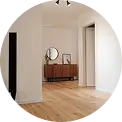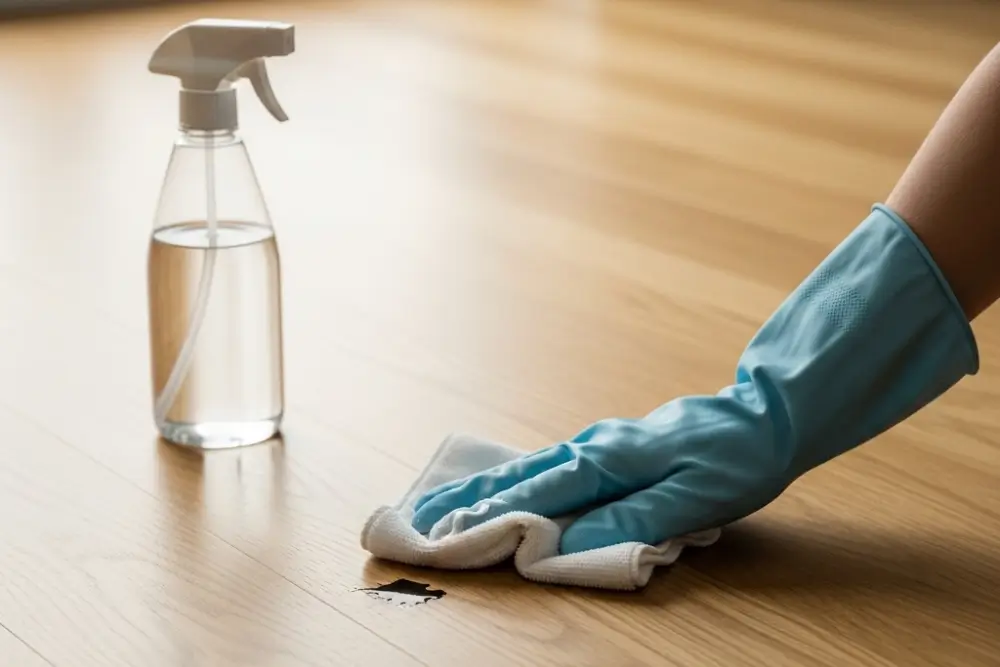Brick floors, while being our most serviceable companions and literally the most comforting surfacing underfoot, are (quite unluckily) subjected to huge damage, wear and ultimately aging over time. And if this very issue isn’t attended to on time, chances are that you might end up with nearly irreversibly damaged brick floors.
This does imply the fact that a regular cleaning isn’t particularly enough when it comes to the right maintenance of Brick floors, and there are a number of aspects that you need to take care of, so as to make the most out of your floors.
Let’s get to know all the essential factors as well as lucrative tips and tricks in this regard.
Best Way To Clean Brick Floors
We shall begin with the area-based method of brick floor cleaning, so as to effectively cover all the crucial aspects and those bit of differences as well, that go hand-in-hand with the switching of the area under consideration.
Cleaning Interior Brick Floors

Interior Brick floors, of course, do not experience that much of an intense usage, heavy foot fall or wear and tear as compared to those present in the outdoors. However, the dire need for their throughout and regular cleaning remains the same.
- For everyday cleaning (the one carried out on a daily basis), making use of a vacuum cleaner or even a mop works pretty fine.
- The tiny yet harmful dust, dirt and debris particles serve as the root cause of long-term damage, causing wear down of the floor sealer and ultimately harm to the bricks. To deal with this and to not let this take place, you’ll need to carry out a thorough weekly cleaning.
Essential Supplies
- Vacuum Cleaner
- Mops (Microfiber mops work the best)
Mandatory Materials
- Vinegar/ Borax/ Baking soda/ Dedicated cleaner (the one meant for tile and stone)
- Water
Method
- Start by either dry-mopping, vacuuming or sweeping your brick floors, as you normally would.
- You can choose any of the above-mentioned materials and make a solution by mixing your chosen material into about 1 gallon of water.
- 2 tablespoons Borax Powder/ 1-2 tablespoons baking soda/ up to 1 part of vinegar/ manufacturer recommended amount of commercial cleaner are the essential mainstream criteria, you can consider while making the cleaning mixtures.
- Dip your mop (for best and damage-free results, make use of a microfiber one) in the cleaning solution you made and go over with the affected area a dew times, as the first attempt.
- You might require a forceful scrubbing if there is any stubborn buildup or staining present. Alternatively, you can also make use of a scrubbing brush and you should be able to get rid of all the dullness and damage causing accumulation.
- Finish off by wiping the treated area with an absorbent cloth or some towels, so as to get rid of any of the possible solution residues. Let it air dry completely.
For Concrete Floors
You May Need To Know: How To Clean Concrete Basement Floors
Cleaning Patio/ Outdoor Brick Floor

Patio or outdoor brick floors, being situated in a more exposed place, certainly ask for a more detailed and somewhat tough cleaning. This cleaning is often likely to involve more heavy-formula cleaners, as the buildup or staining is also more stubborn and tough to deal with.
Essential Supplies
- Mop
- Garden hose
- Pressure washer (optional)
Mandatory Materials
- Sulfate-based cleaners/ brick acidic cleaners
- Weed killer
- Bleach
- Warm water
Method
- If you’re settling for cleaning with the pressure washer, you need to be extremely watchful during the procedure as the brick flooring has a great chance of getting marked or scratched if exposed to excessive pressure application or very harsh scrubbing.
- Make sure that you use a fan-spray nozzle or the flat one and maintain a certain distance between the nozzle and the surface of the brick. Only go for this method after thoroughly reading the guidelines given by the manufacturer, so as to not end up with any brick discoloration or etching.
- Coming to the manual cleaning, you’ll need to clear out the entire brick patio of yours from any of the debris buildup, by either blowing or sweeping. Besides, if there is any weed growth in the pavers joints, you’ll have to get rid of it as well, with the help of a weed killer.
- If there’s still any bit of the loose soil or dead plant material left, go over the entire space with another attempt of sweeping.
- Start by mixing around 4 cups of bleach into a gallon of warm water and begin pouring small amounts (be careful about not going excessive with the cleaning solution, it will be left and dried out within the pavers otherwise) on the brick surface.
- Keep scrubbing with a stiff bristled brush until you achieve a clear surface. Rinse it all off with the help of a garden hose. You can go for another round of scrubbing if you notice the need to do so.
Some Other Maintenance Concerns Of Brick Floors
Now apart from a regular and a detailed cleaning, there are a number of other minimal yet serious issues much likely to be experienced with the utilization of brick floors over time.
And it’s needless to say that if you don’t deal with them in a right and timely manner, they have a huge possibility of becoming major problems.
For a further and precise idea, take a look ahead.
How To Remove Water Stains From Brick Floors
Hard water staining is one of the most common concerns experienced with brick floors as the whitish haze (mineral residue) seems extremely unpleasant.
Nevertheless, you can always fix the situation in the effective and convenient ways mentioned ahead.
- Hard water stains require to be treated with an acid-based cleaner and the most effortless way to do so is to invest in a commercial brick cleaner. It will do the job most effectively for you, without having to do too much.
- Alternatively, you can make a DIY cleaner simply by mixing a cup of vinegar into a gallon of water.
- With the help of a scrubbing brush, work your way by cleaning the affected area with your DIY cleaner. Rinse off with clean water and you should be left with perfectly cleaned and unstained floor(s).
How To Deal With The Grout Present In Brick Floors
Grout lines being the most vulnerable part of the brick floor, are highly susceptible to absorb any of the spills or splashes. And the consequences are often discolored grout or at worst, severe damage to the bricks.
You can put an end to this concern in the following ways:
- Sealing the brick floor once a year works amazingly in terms of keeping any of the materials from penetrating into the bricks or even lines.
- Commercial cleaning products also work quite effectively in this regard.
- Alternatively or for a homemade recipe, you can make a paste by combining equal parts of water and baking, followed by applying this mixture to the affected areas and scrubbing with a grout brush. In the end, you can wipe off the treated area with an absorbent cloth and you should be able to get trouble-free floors.
- Steam cleaning, as a matter of fact, is the most effective approach to dealing with the grout. However, you need to be careful with the sealers as steam cleaners often end up removing them.
A Few Essential Tips And Guidelines To Remember
These extremely lucrative tips and tricks will help you prolong both the life and working of your brick floors, as they are related to both the maintenance procedures as well as general look after.
- Never mop with dirty water or murky solution as this can hugely damage your floors. Keep checking your water container (bucket, tub, etc.) to see if it has started to turn murky or dirty. And whenever you get to notice this, do consider throwing that solution away and continuing the working with a new cleaning.
- If you get to experience fine dust with your freshly installed brick floor, start flushing the bricks with excessive water and keep doing so till you get rid of all the Muriatic acid.
- Try going for the use of a commercial cleaning element for cleaning the just installed floors as it generally doesn’t cause a lot of dust and is easy to wash off, as well.
- Choose a sealant very carefully for your flooring as an unsuitable one can easily cause discoloration of the bricks and can even turn it yellow such as a polyurethane or wax sealer.
- For instantly reviving the look of your brick floors, you can make use of a table salt and dish soap mixture as scrubbing the floors with this paste will effectively help to get rid of the dullness.
- Staining, painting and whitewashing are some of the smart ways in which you can entirely change the look of your brick floors and make it appear a lot more attractive than before.
FAQs | Frequently Asked Questions
How To Remove Wax From Brick Floors?
A solution of ammonia and water will be your ultimate help in this regard. Start by mixing around ¼ cup of ammonia along with up to 8 cups of water to make a cleaning mixture. With the help of a cleaning mop, work your way by applying the mixture to the floor, eventually stripping away all of the wax residue. You’ll need to mop and scrub the floor surface multiple times, till you succeed in getting rid of all the wax present. Finish off by rinsing the floor with clean water and leaving it to dry.
How To Clean Very Rough Brick Floors?
In the first step, you’ll need to get rid of the debris present on the floor surface and you can make use of either a vacuum or a mop for this purpose. Going over the floor with a mop and water generally are quite okay for rough and unfinished brick floors, in order to keep any accumulation at bay. Besides, if you want an even detailed cleaning, you can go for mixing a certain mild detergent into the water and use it to clean your floors.
Is It Okay To Use Vinegar Over Bricks?
In the first place, the answer is certainly a big “No”, i.e. you must never make use of vinegar in order to clean your brick floors. Moreover, this precaution goes the same for various other types of floors as well, such as concrete, flagstone or paver. The reason is, of course, the acidic nature of Vinegar that can cause serious damage to the brick floor and while it might be your favorite part of all the domestic cleaning hacks, it certainly isn’t something that should be used over brick floors.
Can Brick Floors Be Cleaned By Steam Cleaning?
Steam cleaning, actually is quite an effective way of deep cleaning your brick floors, however, in such a situation, you’ll need to ensure the fact that you make use of a hard-floor attachment alongside, as well. As the steam from the cleaner penetrates through all the brick pores, it carries out all the grime, dirt and debris buildup, leaving the floors thoroughly clean, stain free and a lot more hygienic than before.
What’s An Effective Homemade Recipe For Cleaning Brick Floors?
Dish detergent (dish soap) and baking soda mixture is one of the most effective homemade hacks for cleaning and decluttering brick floors. You can start by making a thin paste of about 3 tablespoons of dish soap along with half a cup of baking soda and spread this mixture onto the brick surface. Let it rest for about 10 minutes, followed by scrubbing thoroughly until you manage to get rid of all the accumulation or staining. Finish off by rinsing the floor with warm water.
How To Get Rid Of Mortar Residue From The Brick Floors?
Mortar Residue, as a matter of fact, is an alkaline material and recalling the basic chemistry it only needs to be diluted with an acid, till the situation is fixed. Don’t look forward to vinegar for this purpose as vinegar is only a mild acid, rather you’ll be needing a stronger formula to get the job done. And the best recommendation in this regard is Hydrochloric acid otherwise known as Muriatic acid. You can go with a 1:10 criteria for making the solution, while being extremely careful, since you’re dealing with a strong acid.
What To Do To Revive The Look Of Brick Floors?
Considering the fact that your brick floors have reached irreversible damage, you’ll need to make use of either a concrete paint or a concrete stain to revamp the look. Brick floors that have been aged a lot or have been experiencing extreme damage can’t possibly be revived with merely a sealer application, since the damage is often beyond the capacity of any sealer. Using a concrete paint or stain is an effective way to revive the look of your brick floors.



